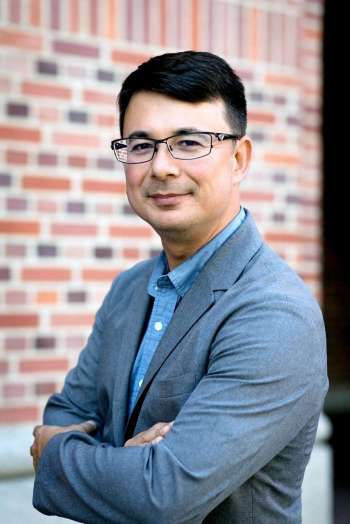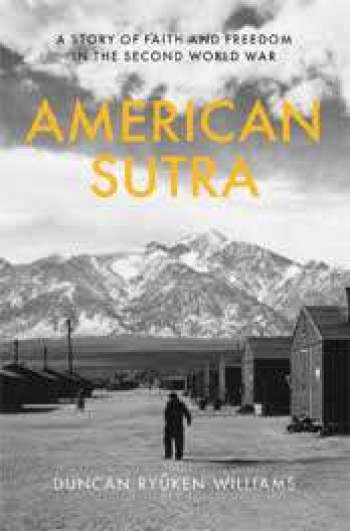American Sutra: On the Incarceration of Japanese Americans in WWII
By Harsha Menon
Buddhistdoor Global
| 2019-05-23 | Duncan Ryuken Williams is a professor of Religion and East Asian Languages and Cultures, director of the USC Shinto Ito Center for Japanese Religions and Culture at the University of Southern California, and author of the new book American Sutra: A Story of Faith and Freedom in the Second World War (Harvard University Press 2019).
Buddhistdoor Global: I see you have a degree in religion as well as an ordained title. Can you tell us about being a scholar-practitioner and how that informs your work?
Duncan Ryuken Williams: There are many works onJapanese-American incarceration in World War Two—especially those that recount the government and the media’s perspective on this history—but American Sutra is the first to highlight the role that Buddhism played in this history, telling the story from the inside out. In certain older forms of Buddhist studies, there has been a tendency to valorize scholarship written from the outside in. Perhaps being a scholar-practitioner has made me sensitive to the need to take a “middle path” in writing history that takes perspectives from within and without equally seriously.
 Dr. Duncan Ryuken Williams. Image courtesy of Duncan Ryuken Williams
Dr. Duncan Ryuken Williams. Image courtesy of Duncan Ryuken WilliamsBDG: I remember you saying that writing American Sutra took you 17 years, is that correct? Can you reflect on the process and what you gained by taking so much time to complete the book?
DRW: The long process of interviewing more than 100 camp survivors, translating thousands of diaries and letters of camp survivors, poring over tens of thousands of government records for the book allowed me to think deeply about which stories made the most sense to include for as broad a readership as possible. The 17-plus years from conception to completion also meant that instead of the book being released during the Obama years (when it may have been received as part of an arc of American opening toward racial and religious pluralism), it was released in the midst of the Trump administration, when issues of immigration, race, religion, and American inclusion/exclusion have come into sharp focus.
BDG: Putting the words “Buddhist” and “incarceration” together might not be something many Americans would think to do! Can you talk about the reception of the book as you have toured and spoken about it? What is it like bringing out this lesser-known aspect of American religious history to a wider audience?
DRW: Given the place of Buddhism in the American religious and cultural landscape in 2019—with mindfulness classes at Google, Sen. Mazie Hirono’s work as the first elected Buddhist to Congress, or Oprah interviewing Thich Nhat Hahn—many in the American Buddhist community as well as the wider American readership seem to be quite surprised that not that long ago Buddhism was seen as a national security threat. People seem shocked that Buddhism was cited by Lt. Gen. John DeWitt, the chief architect of the forced removal and confinement, as a factor in the mass incarceration of more than 110,000 persons of Japanese ancestry during WWII. Yet, people seem equally impressed that the Japanese American community—over two-thirds of whom were Buddhists—drew on the teachings and practices of the Buddhist tradition to help them find liberation in the midst of incarceration.
BDG: Why do you think a non-Christian religion would be perceived as threat in the United States? Is it just a question of an imagined identity, or a more racial underpinning to the sentiment of fear that could be underlying the Christian identity narrative?
DRW: There is a long history of America being conceived of as a fundamentally White and Christian nation—this sentiment is certain in evidence even in recent times. From the rhetoric of America being overridden by a “yellow horde” to language about the “heathen Chinee” (a slur made popular during debates around the Chinese Exclusion Act, the late 19th century immigration law that was the first to target a group of people for exclusion), the sentiment that race or/and religion could define American belonging was dominant in the decades prior to WWII. The formula of immigrants seemed to be to assimilate into whiteness if possible (eg. the Italians and Irish, who were initially made to feel unwelcome in an Anglo-Protestant conception of America) or if that was racially impossible, to convert to Christianity (eg. for Asians). For those who were Asian and Buddhist, the double marking of the community as un-American, if not anti-American, has been an enduring challenge.
 American Sutra. Image courtesy of Harvard University Press
American Sutra. Image courtesy of Harvard University PressBDG: I remember you saying that the only book that was allowed in the internment camps was the Christian Bible. Do you see parallels to current immigration laws that refugees to the US have to be sponsored by one of two organizations, both of them Christian? In your view, how much is this conversion agenda still a part of US immigration law?
DRW: During the initial debate around the Trump administration’s travel ban, the first versions of the so-called “Muslim ban” (based on candidate Trump’s vow to enact a “complete shutdown of Muslims” entering the US) included an exemption for Christians in the majority-Muslim countries targeted by the ban. This language was removed in subsequent versions of the executive order so that it could pass constitutional muster in a Supreme Court test, which would have disapproved of such clear markings of religious preference and animus toward one religion. So, the often subtle privileging of Christianity is not surprising when it come to refugee-related policies.
BDG: How do you carry the stories of the pain and hardship you unearthed as part of your research? Has it affected your practice and have you been able to perhaps transmute some of that suffering?
DRW: People during WWII drew on their Buddhist faith to help orient them at a time of dislocation and loss. I’ve found that how we orient ourselves in the world and narrative stories about ourselves is also a critical part of walking the Buddhist path. I believe the post-publication storytelling work has been an important part of making sure that the Buddhist individuals and families who enduring much suffering are not erased from history, but rather celebrated as important pioneers of American Buddhism.
BDG: What is your next project?
DRW: I hope to write sweeping history—from the Chinese Exclusion Act to the present—of how race, religion, and American belonging appears from an Asia-Pacific perspective.
BDG: Thank you so much for sharing your time!
See more
American Sutra (Duncan Ryūken Williams)
Related features from Buddhistdoor Global
The Birth of an American Form of Buddhism: The Japanese-American Buddhist Experience in World War II
Julius Goldwater: Protector of Japanese American Buddhists
“Hyphenated-American”
More from Buddhism in America by Harsha Menon

















